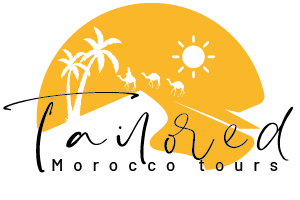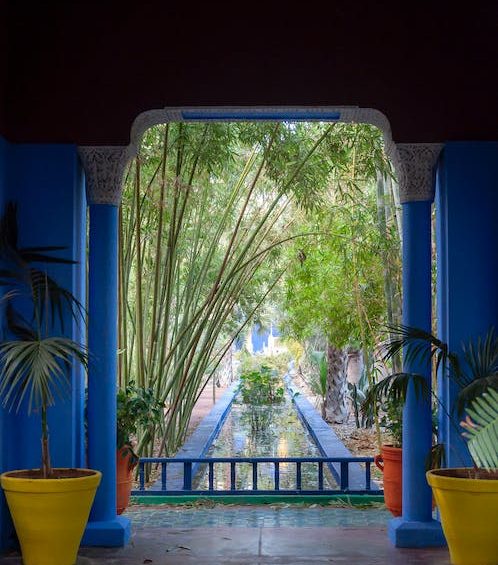French clothing designer Yves Saint Laurent and his partner Pierre Berge bought Jardin Majorelle in 1980 to preserve the vision of the first owners. French landscape painter Jacques Majorelle, and to ensure it remains accessible to the general public.
The garden was first established in 1924 and featured the psychedelic desert with 300 species of plants across five continents. The heart of the garden is Majorelle’s studio in electric blue that houses the Musee Berbere, which showcases the vast landscape of the indigenous peoples of Morocco by displaying more than 600 artifacts.
Since its inception, this place has grown in popularity and is now ranked as the most popular tourist destination, with an average of 950,000 visitors per year. It’s not the tranquil oasis of a decade ago, yet it’s an extremely fashionable place with beautiful gardens, art deco-inspired architecture, and a superb museum. To make room for the crowds of guests, the YSL Foundation expanded the gardens in December of 2018, opening the part that contained Villa Oasis, where Berge was a resident until his death in 2017.
Jardin Majorelle also houses a beautiful courtyard cafe, a tiny photoshop, a bookshop, and a chic boutique that sells Majorelle blue slipper fabrics and Amazigh-inspired jewelry that is influenced by YSL designs.
The entire area within Jardin Majorelle is wheelchair and stroller accessible.
History of Jardin Majorelle
It was 1923 when Majorelle decided to lay his roots in Marrakesh and bought a four-acre palm grove along the edges of the medina. It was planted with poplars, which gave the house its initial name, Bou Saf Saf (meaning “the poplars” in Arabic). The first home built here was Moorish in appearance, with the traditional adobe tower. In 1931, after Majorelle had enlarged the land to nearly 10 acres, he engaged French architectural firm Paul Sinoir to design a studio and villa built in the style of art deco.
The structure that is now famous on Instagram (now home to the Musee Berbere) was Majorelle’s studio and workshop. The principal residence, in which Majorelle, Yves Saint Laurent, and his partner Pierre Berge lived was named Oasis Villa Oasis after YSL. The house remained privately owned until the death of Berge in 2017.
Who was Jacques Majorelle?
While it is famous for its time as Yves Saint Laurent’s residence, Jacques Majorelle (1886-1962) donated these gardens to Marrakech. The artist was a French artist from Nancy whose dad, Louis Majorelle, was a famous furniture designer. Majorelle’s exposure to art nouveau – a rich one with organic themes and motifs- sparked his love of animals and plants. Majorelle came to Morocco at the beginning of 1917. He was instantly captivated by the same hues and vibrant street life of Marrakesh, enticing YSL one century later.
Majorelle was known for his Orientalist artworks from North Africa and particularly Morocco Some of the repro 1920s travel posters available around the medina represent his creations. The distinctive cobalt blue color of the buildings of Jardin Majorelle is a unique feature designed by Majorelle himself and was inspired by the striking Moroccan blue skies and the shades of blue found in traditional Moroccan tiles and hair-turning blue drapes that the Tuareg people of southwestern Sahara wore. The color came to be known as “Majorelle Blue” and was even registered as such.
Plants in Jardin Majorelle
The gardens host more than 300 species of plants that are spread across five continents. They were discovered through Jacques Majorelle over several decades of traveling worldwide. The gardens were opened to the general public on the 27th of July, 1947. However, they were shut down following his passing away before Yves Saint Laurent and Pierre Berge set out on a mission to protect them from developers of property.
Botanists with a passion for learning will be in heaven. However, Jardin Majorelle is a beautiful area to visit, regardless of whether you’re an avid plant lover or not. The regular signage provides useful illustrations to assist visitors in identifying all kinds of plants, from Mexican agaves up to Chinese windmill palms to North African date palms; however, it would be helpful if the famous names were listed in addition to scientific terms.
The dense clumps of bamboo can reach the heights of desert towers by a shard of sun. The exotic bamboo groves of Jardin Majorelle are well-known and loved, but you may not be expecting the massive quantity of graffiti. Over the years, visitors have displayed their affection for the gardens by naively engraving their initials on the famous stalks of the gardens and even some of the huge succulents. This environmental graffiti has become a source of ridicule and a nuisance, but the botanists of the gardens are aware that it’s damaging the plants. Cutting into plants is now prohibited.
Musee Berbere
Majorelle’s art deco studio, which is electric blue, is home to the stunning Musee Berbere, which showcases the vast array of Morocco’s indigenous people through exhibits that include more than 600 artifacts. These include metalwork and woodwork as well as textiles and rooms of traditional Moroccan costumes, all presented with the flair of a catwalk. The best part is the sparkling mirrored space with a display of filigreed and chiseled, and enameled jewelry.
Villa Oasis Gardens
In December 2018, the Villa Oasis gardens opened to visitors for the first time. The gardens are accessible via a path strewn with vibrant bougainvillea and separated from the main garden. They are, in my opinion, the most lavish and captivating of the two and have greatly increased the visitor’s attraction to the entire complex.
The house itself is bigger than the studio. It is more Oriental in its design, blending Marrakesh’s signature red terracotta along with the electric blue of Majorelle and Islamic greens on the tiled façade and roof. The bamboo groves in the main garden are transformed into huge succulents, cacti, and mature palms. There’s also a series of tranquil water features brimming with koi carps, raucous frogs, and pads of lily, the biggest of which is surrounded by an unlit white pavilion.
It is worth noting that the Villa Oasis house isn’t open to the public (only a few expensive hotels can offer exclusive tours at this location). Therefore, you’ll be able to envision the generosity of its interiors. The salon is a work of Moroccan art, featuring elaborately painted cedarwood, stunning Zöllige (colorful geometrical tile work), and high-end art deco furniture.
Yves Saint Laurent Memorial
A very well-known area within the gardens is the Memorial. It’s located on the back wall, opposite the garden from the entrance/exit. This is a beautiful area if you can keep out photographers and Instagrammers. It’s an older Roman pillar that Yves Saint Laurent and Pierre Berge discovered on the beach of Tangier. Berge Yves Saint Laurent’s business associate and love partner was added to the Memorial following his passing in Provence, France, in 2017.
How to get a place to stay close to Jardin Majorelle
Jardin Majorelle is in the Ville Nouvelle neighborhood of Marrakesh, which is what they call the “new town” with modern amenities. The medina hotels beat the ones in Ville Nouvelle, hands down, for the ambiance. However, If you’re looking for an upscale sleep, then the Ville Nouvelle and Gueliz area is a great choice. In this area, international hotels are designed for package vacations’ holiday market. There’s nothing better than the price to stay in this area; however, most hotels offer bars on site as well as larger pools than you’ll see within the medina.




